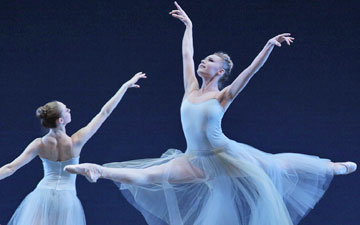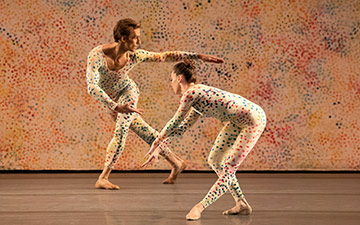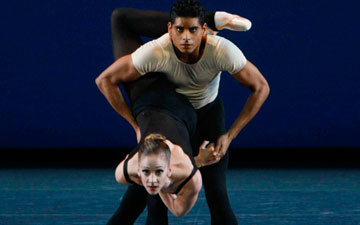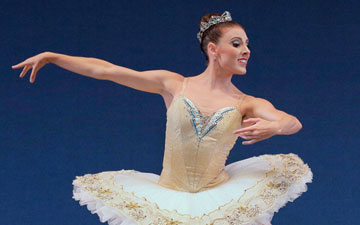
© Paul Kolnik. (Click image for larger version)
New York City Ballet
La Sylphide, Tchaikovsky Piano Concerto No. 2
★★★✰✰
New York, David H. Koch Theater
14 February 2016
www.nycballet.com
Last year, Peter Martins, the Danish-born director of New York City Ballet, set La Sylphide on his home company. The staging, which was created in 1985 for Pennsylvania Ballet, is more or less traditional, though Martins eliminated the intermission between the first and second acts. The choreography is all by August Bournonville, the nineteenth-century choreographer who brought the Romantic style to Denmark and preserved it in his many fairytale ballets. The designs, a cartoonish Scottish manor and a psychedelic, tendril-filled woodland, were conceived by the New York artist Susan Tammany. (Because of its bluish glow, the second act looks almost as if it took place under water.) This week, it returned to the repertory.
Martins writes in the program that La Sylphide was the first ballet he saw as a boy at the Royal Danish Ballet school; later, he performed the role of James, the romantic dreamer whose infatuation with a wood-nymph seals his fate, many times over. It’s odd, then, to see what little feeling he seems to have for the ballet and, especially, for its characters, at least on the evidence of this revival. Last year this sketchiness could be chalked up to the foreignness of the style. This season, it seems more like an inescapable reality. This Sylphide is like a shell, polished and smooth, but empty inside.
The Bournonville footwork and even the mime are there, but there’s little sense of joy or pathos of any kind. Even the Scottish reel, usually a boisterous eruption of stomping and criss-crossing lines, felt relatively flat at the performance I saw on the evening of Feb. 14. The flaccid playing of the New York City Ballet orchestra was no help. (Cutting the intermission also makes the ballet feel flimsy.) The mime was overplayed, the characterizations – particularly that of the witch, Madge – too broad. The art of La Sylphide is in the details. No Madge should be like any other; she should be not only scary, but also interesting, full of twists and quirks that suggest the motivations that arouse her malice. Stomping around the stage and letting out an occasional cackle doesn’t begin to plumb the possibilities of this character. (A visit to New York by a group of dancers from the Royal Danish Ballet last year was a vivid reminder that one doesn’t need sets or live music to evoke a world.)
For the most part, the dancers pull off the tricky choreography, full of beaten jumps that continually change direction, with clarity and aplomb, though of course they lack the upper-body graciousness and rocking quality of the Danes. But that’s not the problem: no-one expects the City Ballet dancers to dance like the Danes; what’s missing is the spirit.

© Paul Kolnik. (Click image for larger version)
Tiler Peck was convincingly soft and caressing, though not terribly nuanced, in her interpretation of the Sylph. As always, the key to her performance was the phrasing, the way she linked the steps by activating every inch of her body, from her head and neck and shoulders to the tip of her fingers and toes. With her back, she amplified the movements, made them sing. She’s not a natural sylph; she’s too strong and too grand for the part, but with her abundant control, she manages to keep these qualities in check, for the most part. The one element she’s missing is buoyancy. She has a strong jump, but not a particularly light one.
Andrew Veyette, her James, looked tired, as he has all season. The male variations in La Sylphide are killers. There’s no time to rest, as the bottom of each jump doubles as the beginning of the next one; the zigzagging lines and shifting focus are relentless. The best one can say is that Veyette got through it. Troy Schumacher, as Gurn, made a better impression in his first act solo. (I’m sure it’s not the first time the protagonist has been out-danced by his rival.) His lovely, arching grand jetés en attitude were a particular highlight. But all in all, this Sylphide failed to quicken the pulse.
Not so the performance of Tchaikovsky Piano Concerto No. 2 that followed. This ballet, originally created in 1941 for a tour to South America by Ballet Caravan – predecessor of NYCB– was Balanchine’s first foray into the grand, imperial style of his youth and training. The choreography takes on Tchaikovsky’s throbbing score measure for measure, matching each crescendo, each cadenza with a new wave of movement or a new pattern. Each voice in the orchestra finds its reflection onstage. The cast consists of a corps of twenty-two, four demi-soloists, a female soloist, and a lead couple. The female soloist tears around, leading two men in a flying race, spinning endlessly, hopping on pointe, gathering the women together for phrases of beaten jumps. In this role, Ana Sophia Scheller was strong, confident, dynamic.

© Paul Kolnik. (Click image for larger version)
Teresa Reichlen, in the lead role, was something more. She was born to dance this ballet. It shows off her best qualities: the freedom of her movement, the amplitude of her lines, the sense of ease and effortless authority she brings to her dancing. When the women bow to her, each group in turn in a wave around the stage, it seems the only possible response to her presence. She performs the choreography’s tricky passages, like a turn with the leg skimming the floor, stopping on a dime, as if they were nothing; so too, the transitions from one torqued, off-kilter pose into another.
The slow second movement contains the ballet’s most striking image. The man (Tyler Angle) joins hands with two chains of women, one at each side, bending and pulling the chain across the stage, like a ribbon. His partner, Reichlen, appears, pushing her way through this haze of women, encircling him in a light embrace, only to disappear once again. This is Balanchine’s Vision Scene, his first homage to Sleeping Beauty, but not his last.

















It saddens me very much indeed to read that a company directed by Peter Martins gave such a leaden performance of La Sylphide. And while it’s perfectly true that nobody dances Bournonville like the Royal Danish Ballet, when Frank Andersen, former artistic director of the RDB, sets the work and coaches the dancers, they can come pretty close. Andersen set Act III Napoli on Oregon Ballet Theatre’s dancers last fall and it was an ebullient and exciting performance.
One tiny correction: it was American Ballet Caravan, and specifically Marie Jeanne, for whom Balanchine made Tchaikowsky Piano Concerto 2 (then called Ballet Imperial), not Ballet Caravan, which was Kirstein’s company, best known for premiering Billy the Kid in 1938. Picky of me I know, but Balanchine did no choreography for the earlier company. Lovely writing Marina!
Thanks Marina,
As a reader, I completely trust your opinions, because you tell us why you hold them. It’s wonderful to read a report of an evening in the theater when one is far away. Makes me feel I was there.
–EK